|
Astrology for Magicians
and Metaphysicists - Introduction
In the following lessons you will find an introduction
to natal astrology. I am using the key-word method, because I realized
that this is the most efficient way to gain the skills of natal chart
interpretation. Conversely, you may use the same method to set up
your astro trend generation units for the purpose of taking control of
your stars!
How
to Draw and Evaluate an Astrological Chart
The astrological chart is a representation of the
astrological factors at the time of the event it describes. In the case
of a birth chart, it represents the positions of the planets and houses
as seen from the place of birth at the time of birth.
The following is not designed to give you an understanding
of the astronomical factors involved. I will rather give you a step by
step introduction that helps you understand the structure of a chart,
to design it and to understand it. You need not know the astronomical
basis of astrology for this task.
I am going to use the method that shows the planets
as they are in the zodiac (European method) rather than the twelve-equal-wedges
method that is still practiced in the Anglo Saxon countries. This latter
method shows the astrological signs and planets in the houses. With this
antiquated method it is rather difficult to see and evaluate midpoints
and structural patterns of aspects, both of which are important for our
task to generate astrological trends. If you have a computer program that
calculates your charts, be sure to have a printout that shows the planets
and houses in the zodiac -- the way you are going to learn in the following
pages.
It is the ZODIAC in which you will draw all the planets,
house cusps, and other factors of the chart. This zodiac is represented
by a circle of 360 degrees. The degrees are counted in a counter-clockwise
manner. This is a free course in
natal astrology, this free astrology course touches upon astrocartography,
it teaches free astrological readings, introduces to horary astrology,
predictions, and astrological interpretation, divination, also personal
horoscopes and astrological consultations, as well as astrological chart
interpretations, astrological advice, astrology study, vedic astrology,
and western astrology.
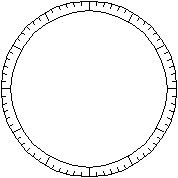 |
The zodiac is subdivided into twelve equal parts
of 30 degrees each. These twelve equal parts are the astrological
signs. The beginning of the zodiac is set at the point that the
sun occupies at the exact time of the spring equinox. This point
is 0 degrees of the sign of Aries. You find this point at the right
side of the chart. From there the 30 degrees of Aries are counted
in a counter clockwise manner until 30 degrees Aries which is 0
degrees Taurus.
For your convenience, each sign is subdivided
into six sections of five degrees each. As you proceed in magical
astrology, you will find out that this subdivision has a very special
meaning.
|
This is a free course in natal astrology,
this free astrology course touches upon astrocartography, it teaches free
astrological readings, introduces to horary astrology, predictions, and
astrological interpretation, divination, also personal horoscopes and
astrological consultations, as well as astrological chart interpretations,
astrological advice, astrology study, vedic astrology, and western astrology.
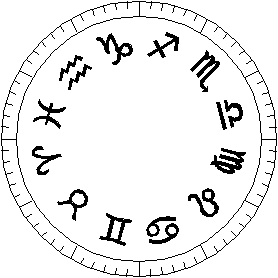 |
The circle on the left shows the twelve signs
of the zodiac.
The zodiac is always here. Everything else moves
through the signs of the zodiac at its own speed. The Sun completes
one orbit through the zodiac in one year, the Moon in 28 days, Jupiter
12 years, etc. The system of the houses makes one rotation through
the zodiac every twenty-four hours. This movement is cause by the
rotation of the Earth around its axis.
|
This is a free course in natal astrology,
this free astrology course touches upon astrocartography, it teaches free
astrological readings, introduces to horary astrology, predictions, and
astrological interpretation, divination, also personal horoscopes and
astrological consultations, as well as astrological chart interpretations,
astrological advice, astrology study, vedic astrology, and western astrology.
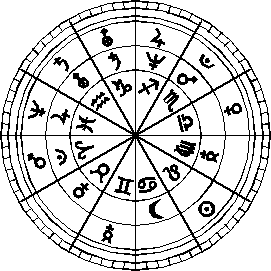 |
Rulers of the
signs
Each sign is affiliated with one or two planets
whose action, or function, best corresponds to the energy of the
sign. Traditionally these planets were called the "rulers" of the
sign. The following diagram shows you the rulers of each sign. The
outside circle shows the day-rulers, the central circle shows the
night-rulers, the inner circle shows the signs.
|
his is a free course in natal astrology,
this free astrology course touches upon astrocartography, it teaches free
astrological readings, introduces to horary astrology, predictions, and
astrological interpretation, divination, also personal horoscopes and
astrological consultations, as well as astrological chart interpretations,
astrological advice, astrology study, vedic astrology, and western astrology.
 |
Elements (Triplicities) and Quadruplicities
You learned about quadruplicities in the course
material. The chart below shows you the distribution of elements
and quadruplicities.
|
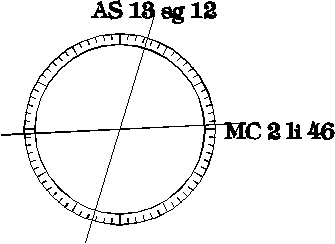 |
Inscribing the houses
The first thing we do is draw the cusps of the
twelve houses into the circle of the zodiac. We work with a chart
for September 14, 1974, at 1:33 p.m. daylight savings time in New
York.
The twelve houses are twelve sections that are
distributed in the zodiac in a counter clockwise manner. Unlike
the signs of the zodiac, the houses are not of equal size.
|
The cusp (= beginning) of the first house, or ascendant,
is at 13 Sagittarius and 12 minutes of arc, or 13:12 degrees of Sagittarius.
This, then, was the point of the zodiac that was rising in the East at
that time.
The beginning of the tenth house is at 2 degrees Libra
and 46 minutes of arc, or 2:46 degrees of Libra. The beginning of the
tenth house is called Midheaven. This is so because the midheaven is the
point of the zodiac that is "in the middle of the sky." It is at the point
where the sun is at Noon.
The cusp of the seventh house, or descendant, is the
point in the zodiac that is exactly opposite the ascendant. It is 13 degrees
Gemini and 12 minutes of arc, or 12:13 degrees Gemini.
The cusp of the fourth house is on the opposite side
of the tenth house cusp, in 2:46 degrees of Aries.
We proceed to draw all other house cusps into the
chart. With the houses drawn into the chart, you see that the houses are
not equal. The first house measures from 13:12 Degrees of Sagittarius
to 17:22 degrees of Capricorn. It is slightly larger than 30 degrees,
while the eleventh house measures from 1:11 degrees of Scorpion to 23:39
degrees of the same sign, hence it is much smaller than 30 degrees.
The axis from the first to the seventh houses marks
the horizon.
The axis from the tenth to the fourth houses marks
the extension of the meridian.
The houses from one through six are always below the
horizon.
The houses from seven through twelve are always above
the horizon, visible from the place of the event.
The houses are always in the same sequence, from 1
through 12.
I prefer to write the house numbers in Roman numerals.
I do this so that they will not be confused with numbers that mark the
position in degrees.
The ascendant, or the point of the zodiac that rises
in the East at the time of birth (or at the time of an event) is by far
the most influential part in a chart. It exceeds even the sun in importance.
In pop-astrology, the person who was born at the time for which the sample
chart was erected, would be considered a Virgo, because this person has
the sun in Virgo. However, considering the importance of the rising degree,
I would say that this person is a Sagittarian with the sun in Virgo.
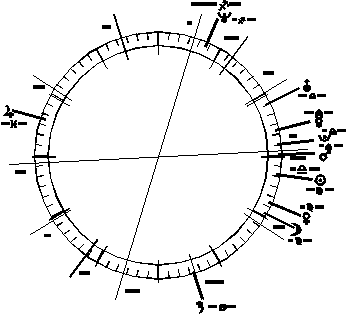 |
Inscribing
the Planets
The next step is inscribing the planets into the
chart. Here we proceed in the same fashion as we did when we inscribed
the twelve houses: The sun is marked into 21 degrees of Virgo 31 minutes
of arc (roughly 21 1/2 degrees on the chart), the Moon is 2:08 Virgo
(the mark is close to the two degree line), etc. |
Inscribing the Aspects
Our next step is to find the aspects between the planets
and inscribe them into the chart. Here you will already see the advantage
of the chart pattern that you learn to use: With a bit of practice, you
can directly read the aspects from the chart.
As you have read in the course, an aspect between
two planets exists if the planets are within the range of specific angles
from each other.
For the beginning, we consider only the major aspects:
The opposition, or 180 degrees apart (opposing), the trine, or 120 degrees
apart, the square, or 90 degrees apart, the sextile, or 60 degrees apart,
and the conjunction, where the planets are close to each other.
An exact aspect is very brief. This is so because
the planets are always in motion. However, an aspect is valid within a
certain range of accuracy. This range is called "the maximal orb" of an
aspect. Consequently, an opposition is valid when the planets are between
172 and 180 degrees apart. This means that the maximal orb for an opposition
is 8 degrees. The same holds for a conjunction that is good up to a distance
of 8 degrees. The square has an orb of 7 degrees, the trine 7 degrees,
and the sextile 6 degrees. The effect of an aspect is strongest when it
is exact. It is weakest when it reaches the orb. For instance, two planets
exactly 60 degrees apart are in their strongest mutual aspect, while when
54 or 66 degrees apart, the influence of the aspect is still noticeable,
but it is very weak.
We inscribe the aspects as lines that connect the
planets in aspect. Draw blue lines for soft aspects (trine and sextile)
and red lines for hard aspects (squares and oppositions). In our sample
chart we used two different dotted lines.
Abbreviations and
Symbols
You are familiar with the symbols for planets, signs
and aspects. In the following I am showing you a system of abbreviations
that allows you to enter the signs, planets, houses, etc., easily into any
computer, or write it with any typewriter or word processor. These abbreviations
are also an excellent tool for another purpose: You can use them to write
astrological "formulas" that you can then translate into statements using
the key word method that you have been taught in this course.
|
Planet or House Cusp
|
Abbr.
|
Sign
|
Abbr.
|
House
|
Abbr.
|
|
Sun
|
S
|
Aries
|
ar
|
First
|
1
|
|
Moon
|
M
|
Taurus
|
ta
|
Second
|
2
|
|
Mercury
|
H (=hermes)
|
Gemini
|
gm
|
Third
|
3
|
|
Venus
|
V
|
Cancer
|
cc
|
Fourth
|
4
|
|
Mars
|
A (=ares)
|
Leo
|
le
|
Fifth
|
5
|
|
Jupiter
|
J
|
Virgo
|
vi
|
Sixth
|
6
|
|
Saturn
|
K (=kronos)
|
Libra
|
li
|
Seventh
|
7
|
|
Uranus
|
U
|
Scorpio
|
sc
|
Eighth
|
8
|
|
Neptune
|
N
|
Sagittarius
|
sg
|
Ninth
|
9
|
|
Pluto
|
P
|
Capricorn
|
cp
|
Tenth
|
10
|
|
Ascendant
|
R
|
Aquarius
|
aq
|
Eleventh
|
11
|
|
Midheaven
|
Z
|
Pisces
|
ps
|
Twelfth
|
12
|
Aspects: write the degrees for the exact aspect: 60
for sextile, 90 for square, 00 for conjunction, 180 for opposition, etc.
Examples for Abbreviation
Jupiter in Leo -- J le
Jupiter in Leo in the Third House -- J le 3
Jupiter in Leo in the Third House Sextile Mars in Gemini
in the First House -- J le 3 60 A gm 1 etc. |

